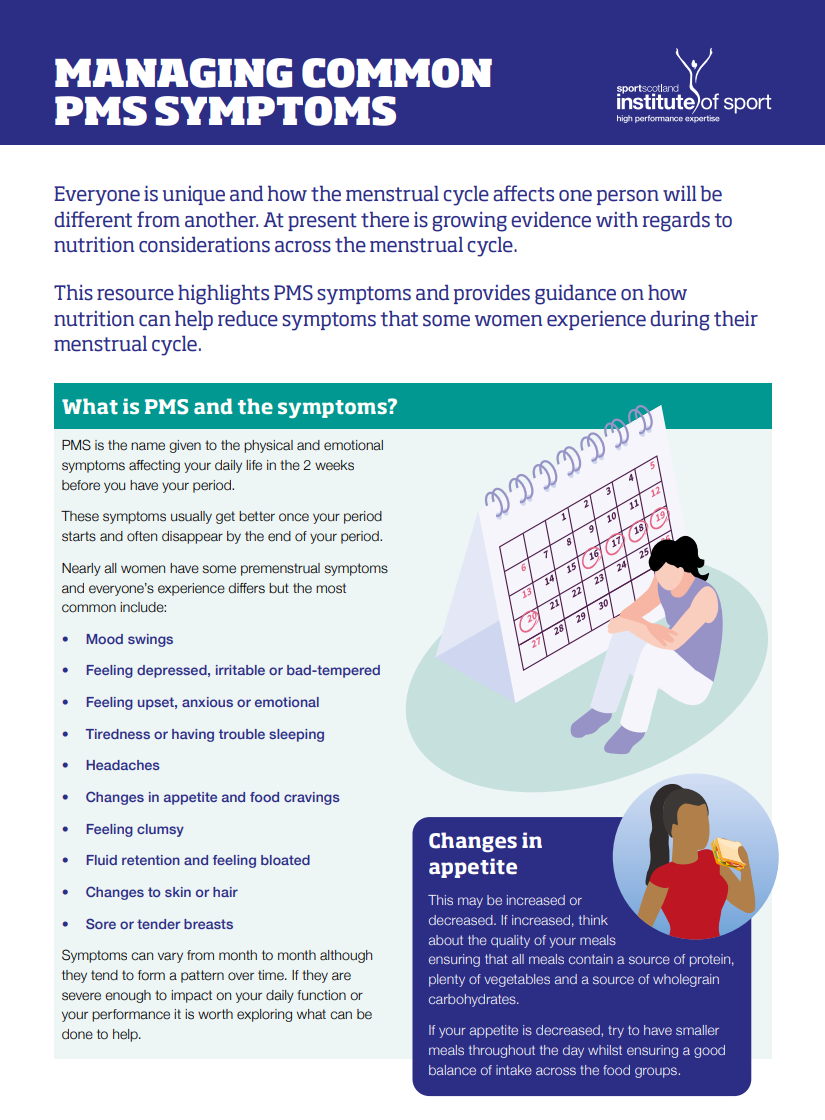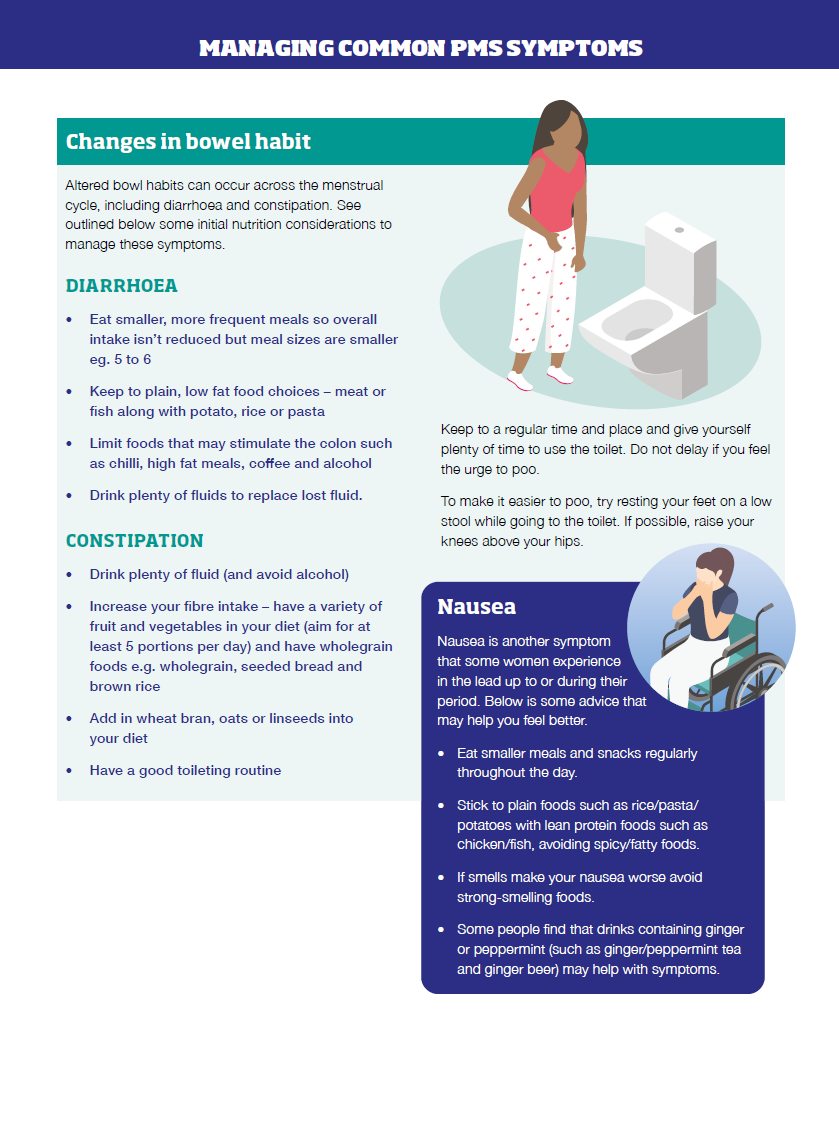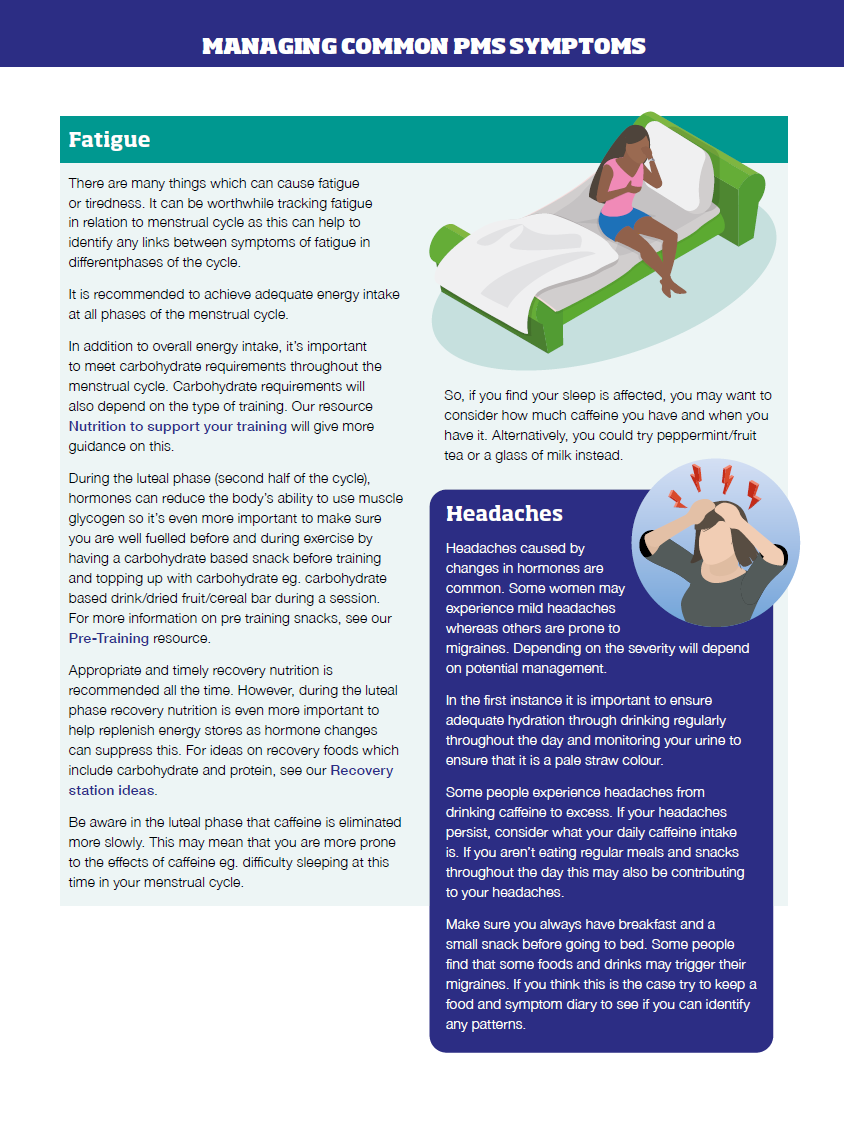Download a copy of the Managing PMS fact sheet: Managing PMS download link





MANAGING COMMON PMS SYMPTOMS
Everyone is unique and how the menstrual cycle affects one person will be different from another. At present there is growing evidence with regards to nutrition considerations across the menstrual cycle.
This resource highlights PMS symptoms and provides guidance on how nutrition can help reduce symptoms that some women experience during their menstrual cycle.
What is PMS and the symptoms?
PMS is the name given to the physical and emotional symptoms affecting your daily life in the 2 weeks
before you have your period. These symptoms usually get better once your period starts and often disappear by the end of your period.
Nearly all women have some premenstrual symptoms and everyone’s experience differs but the most common include:
• Mood swings
• Feeling depressed, irritable or bad-tempered
• Feeling upset, anxious or emotional
• Tiredness or having trouble sleeping
• Headaches
• Changes in appetite and food cravings
• Feeling clumsy
• Fluid retention and feeling bloated
• Changes to skin or hair
• Sore or tender breasts
Symptoms can vary from month to month although they tend to form a pattern over time. If they are severe enough to impact on your daily function or your performance it is worth exploring what can be
done to help.
Changes in appetite
This may be increased or decreased. If increased, think about the quality of your meals ensuring that all meals contain a source of protein, plenty of vegetables and a source of wholegrain
carbohydrates.
If your appetite is decreased, try to have smaller meals throughout the day whilst ensuring a good balance of intake across the food groups.
Bloating
Bloating is when our stomachs are swollen due to a build up of gas in our gut. Being bloated can make individuals feel uncomfortably full but can also cause other symptoms such as pain, nausea
and wind.
Bloating is normal. When we eat, our stomachs are meant to expand, however, some females may experience an increase in bloating symptoms and digestive issues prior to their period, due to a rise in progesterone.
In the first instance some dietary considerations to help with bloating are:
• Eat little and often avoiding large meals
• Chew your food well (10 to 20 chews per
mouthful)
• Avoid sweeteners ending in OL eg sorbitol
• Only have 1 portion of fruit at a time
• Avoid fruit juices and smoothies
• Limit intake of foods that produce a lot of gas such as beans, pulses, broccoli, brussels sprouts, cabbage and cauliflower
Some individuals may find that lactose containing products cause bloating. If this is the case, you can trial lactose free milk and dairy products. If it doesn’t make a difference though then just return to using ordinary milk and dairy products.
Consider keeping a food and symptom diary to track any dietary changes and effects.
Food Cravings
Many women report experiencing food cravings, and these tend to be for carbohydrate rich foods particularly sugar.
The first question to ask is: is it a craving or are you hungry? It is important to note that during the luteal phase (second half) of the menstrual cycle that your basal metabolic rate increases. Therefore, if you are feeling hungry it may be that you haven’t eaten enough.
In the first instance take a few minutes to think about what you have eaten across the day. If you think after these few minutes that it is just a craving, you aren’t hungry, and that you would like to find an alternative to eating, here are some suggestions; go for a walk, read a book, listen to music, watch a film, go for a bath, catch up with a friend on the phone or over coffee.
It is also important to make sure you are getting enough sleep as not getting enough sleep can
have an impact on appetite and cravings.
Changes in Bowel Habit
Altered bowl habits can occur across the menstrual cycle, including diarrhoea and constipation. See outlined below some initial nutrition considerations to manage these symptoms.
DIARRHOEA
• Eat smaller, more frequent meals so overall intake isn’t reduced but meal sizes are smaller eg. 5 to 6
• Keep to plain, low fat food choices – meat or fish along with potato, rice or pasta
• Limit foods that may stimulate the colon such as chilli, high fat meals, coffee and alcohol
• Drink plenty of fluids to replace lost fluid.
CONSTIPATION
• Drink plenty of fluid (and avoid alcohol)
• Increase your fibre intake – have a variety of fruit and vegetables in your diet (aim for at least 5 portions per day) and have wholegrain foods e.g. wholegrain, seeded bread and brown rice
• Add in wheat bran, oats or linseeds into your diet
• Have a good toileting routine
Keep to a regular time and place and give yourself plenty of time to use the toilet. Do not delay if you feel the urge to poo.
To make it easier to poo, try resting your feet on a low stool while going to the toilet. If possible, raise your knees above your hips.
Nausea
Nausea is another symptom that some women experience in the lead up to or during their period. Below is some advice that may help you feel better.
• Eat smaller meals and snacks regularly throughout the day.
• Stick to plain foods such as rice/pasta/ potatoes with lean protein foods such as chicken/fish, avoiding spicy/fatty foods.
• If smells make your nausea worse avoid strong-smelling foods.
• Some people find that drinks containing ginger or peppermint (such as ginger/peppermint tea and ginger beer) may help with symptoms.
Fatigue
There are many things which can cause fatigue or tiredness. It can be worthwhile tracking fatigue in relation to menstrual cycle as this can help to identify any links between symptoms of fatigue in differentphases of the cycle.
It is recommended to achieve adequate energy intake at all phases of the menstrual cycle.
In addition to overall energy intake, it’s important to meet carbohydrate requirements throughout the menstrual cycle. Carbohydrate requirements will also depend on the type of training. Our resource Nutrition to support your training will give more guidance on this.
During the luteal phase (second half of the cycle), hormones can reduce the body’s ability to use muscle glycogen so it’s even more important to make sure you are well fuelled before and during exercise by having a carbohydrate based snack before training and topping up with carbohydrate eg. carbohydrate based drink/dried fruit/cereal bar during a session. For more information on pre training snacks, see our Pre-Training resource.
Appropriate and timely recovery nutrition is recommended all the time. However, during the luteal phase recovery nutrition is even more important to help replenish energy stores as hormone changes can suppress this. For ideas on recovery foods which include carbohydrate and protein, see our Recovery station ideas.
Be aware in the luteal phase that caffeine is eliminated more slowly. This may mean that you are more prone to the effects of caffeine eg. difficulty sleeping at this time in your menstrual cycle. So, if you find your sleep is affected, you may want to consider how much caffeine you have and when you have it. Alternatively, you could try peppermint/fruit tea or a glass of milk instead.
Headaches
Headaches caused by changes in hormones are common. Some women may experience mild headaches whereas others are prone to migraines. Depending on the severity will depend on potential management.
In the first instance it is important to ensure adequate hydration through drinking regularly throughout the day and monitoring your urine to ensure that it is a pale straw colour.
Some people experience headaches from drinking caffeine to excess. If your headaches persist, consider what your daily caffeine intake is. If you aren’t eating regular meals and snacks throughout the day this may also be contributing to your headaches.
Make sure you always have breakfast and a small snack before going to bed. Some people find that some foods and drinks may trigger their migraines. If you think this is the case try to keep a food and symptom diary to see if you can identify any patterns.
Track your Cycle
In order to ensure that the symptoms you are experiencing are occurring because of your menstrual cycle it is advisable to track your symptoms. Whilst doing this you can also keep note of your appetite and food preferences over the cycle to help you recognise and manage symptoms better.
There are a lot of apps* and smart devices available now that will allow you to do this:
• Apple Health
• Clue
• Period Tracker Lite
Check out our Talk, Track, Manage resource for more details.
*Please note that these third-party app suggestions are provided for your information only. These apps are not endorsed by sportscotland, nor does sportscotland have any control of the apps.
We are aware that there are other therapies in the public domain that are associated with managing PMS and while there is anecdotal narrative, robust scientific evidence is lacking at this time. We will continue to monitor and evolve our advice as sound evidence becomes available. If the above measures are not helping and you want to consider other treatment options please contact your GP or Institute Doctor to discuss further.

